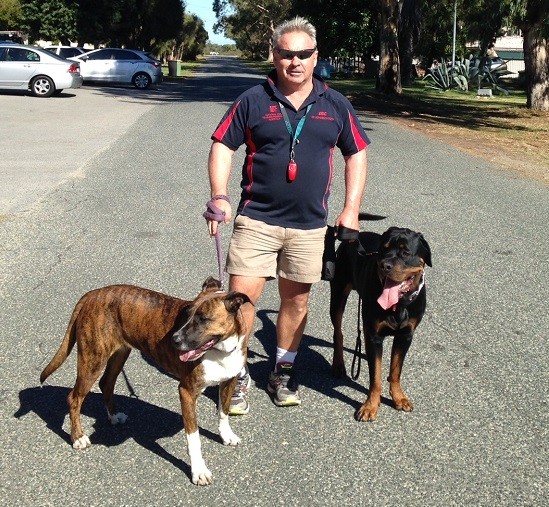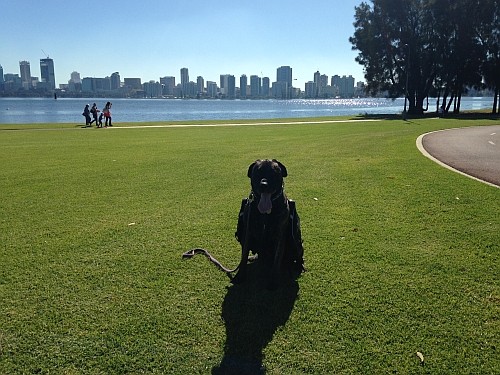UPDATE! We have been contracted to supply services only to a private entity until mid-March 2026. No exceptions.
It is best to wait until early March before getting in touch. Thank you!

Dog training the natural way.
Do you want to live your life in a happy healthy natural way with your dog?
No shouting, screaming, or stressful repetitive dog training!
Eric provides one on one coaching on how to be a calm, assertive, benevolent leader to your dog.
Get your dog’s respect without raising your voice. Bring balance back into your dog’s life….and yours.
Eric also trains deaf dogs.
Check out our Behaviour Issues information below to find what may be affecting your dog.
“No dog is too young or too old to learn good behaviour.”

Some dog owners will mention that while their dog is a beauty at home, the second they leave the front gate it’s like they have a new dog on their hands!
On the lead they have a dog that won’t listen and loses all sense of manners. They’re out of control, headstrong, stubborn, and just won’t stop trying to pull them down the street!
We might laugh along when a passer-by jokes about “Who’s walking who?” without giving away how embarrassing it feels to not be able to control their dog.
Some owners even walk their dog late at night, just to avoid the worry of being seen.
Nobody wants to look like the dog owner who can’t walk their dog properly.
It’s not uncommon that owners will start to view the whole process of walking their dog to be a stressful activity.
What’s to enjoy when your arm hurts from being pulled on every day?
The guilt alone from the dog choking itself on its collar is enough to write the whole thing off as an unpleasant experience.
Thusly, you enjoy walking your dog less and less.
We understand, but we can also help.
Does your dog try and push out of the door when you’re leaving the house for a walk?
Does it get in your way when you’re answering the door?
Or, does your dog simply not let you leave or enter the house without pushing through it as well?
This is unruly behaviour and is one of the first things you should try to control.
Nobody wants to be informed that their dog is creating a nuisance with their barking and howling.
They certainly don’t want to be kept up all hours of the night hearing it themselves.
Problem barking can come from a number of causes, such as Separation-Related-Behaviour.
There are also all kinds of outside stimuli: loud noises like thunder or motorbikes, passing cars or people, other dogs, and people knocking on the door.
Enduring a visit from the local Rangers due to complaints about your dog’s barking is an avoidable stressor.
This is an embarrassing (and often messy) behavioural issue, which some dog owners may misdiagnose as their dog just being badly toilet trained.
Submissive urination can happen iwith dogs that have been excessively punished and is sometimes caused by poor genetics
It also may be due to over-excitement in puppies and adolescent dogs.
A particularly dangerous problem for dogs of any size.
Car chasing can fulfil an emotional need in a dog who is not getting enough stimulation from their owner.
By not correcting this problem, this repetition will become a ‘learned behaviour’ for your dog and difficult to stop.
This may occur when your dog is seeing other animals as prey (ie livestock, cats, small companion animals, other dogs) and wants to attack them.
This is treatable.
Whether you live in suburbia near a road with heavy traffic or a rural area near farms and livestock, an escaped dog is a dangerous situation for everyone.
Although this may be a stressful situation for you to go searching for your dog or having to pick up (and pay) to collect your dog from the pound, your dog doesn’t see it this way.
If your dog is having more fun when outside your yard than in it, this will become a learned behaviour and your dog will always want to escape until you can stop it.
We can assist with training and instructions on correcting the behaviour.
Our tried and tested methods of preparation will make your home friendly and safe for a puppy or dog.
You’ll learn:
How to create a dog friendly environment.
Which plants are toxic to dogs.
How to improve your fencing to keep dogs in and out of certain areas. As well, we can assist you in creating a garden that you, your family and your dog, can share.
People may write off their dog as being dog-aggressive or hating cats when said dog has reacted badly to a new animal in the home.
Actually, the way new pets are introduced to the home needs to be done properly.
This gives your new pet and your dog the best opportunity to cohabitate.
If you’re planning on adopting a new dog or cat, it is best to stage an introduction first before committing to a new pet.
For those not confident in introducing two animals, a Dog Behaviourist’s advice on the introduction is priceless.
Unfortunately, a new baby in the home is one of the most common reasons for a puppy or dog being rehomed or abandoned.
Some people don’t trust their dog around a baby, or have seen behaviour from their dog around the baby which they interpret as negative.
A new baby needs to be introduced to a home with a dog properly.
Remember, your dog was there first.
They don’t know who this strange little bundle of joy is yet!
Coprophagy refers to a dog eating faeces; wWhether it’s their own or other animals.
It’s a major gross-out for people, and dog owners can feel embarrassed if their dog shows this behaviour.
This behaviour should be discouraged!
Diseases can be passed through faecal matter, and that means all the joy of racing to the vets.
Also obviously, no one wants kisses from a dog with this problem!
This is less to do with behaviour, and more to do with learning to manage your dog as he or she ages.
As your dog matures, you may need to learn how to work through any number of problems associated with an aging canine.
These include deafness, blindness, arthritis, incontinence, etc.
Deafness isn’t a behaviour problem, but learning to train a deaf dog that can be a difficult task for a dog owner. You will need to learn training techniques, such as non-verbal commands and body language.
Deaf dogs can also be trained with Remote Collars (please see below).
A short and simple name, but what can be a big problem for you, your dog, and your outlay on vet bills!
Pica refers to dogs who swallow any objects that aren’t food.
They do this for no apparent reason.
There are crazy stories online about dogs eating some really strange objects.
Even simple things found in your backyard (ie clay, pebbles, etc.) aren’t good for your dog either.
A very distressing situation for a dog owner is watching their dog biting, chewing, scratching, and nibbling at themselves excessively.
Eventually a point is reached where the dog is losing hair, bleeding, and even having infections from the wounds.
This problem is often stress related, but regardless needs to be corrected for your dog’s own wellbeing and health.
A pretty common use of dogs in comedy situations is where the pooch that starts humping something or someone.
In real life, humping of legs, toys, furniture, or other dogs is a situation that owners can find funny or really embarrassing.
Regardless, it is a behaviour that shouldn’t be encouraged or ignored.
With the right training, these packages are suitable for dogs of any age.
This is also a suitable choice for owners of dogs with hearing impairments.
It’s one of the few ways a deaf dog can be allowed off-leash.
Half Day Package (collar not included):
If you are providing your own remote training collar the cost of a half day will be $250.00 However, Eric must approve of the quality of the collar you are using first.
Any collar used will have to be up to the standard of E collar technologies with the mini educator.
A preferred entry level remote training collar is the Dogtra IQ dog training collar (or remote trainer) with collar.
Half Day Package (collar included):
This will include the Dogtra IQ plus collar, which will be $500.00.
In both packages a written plan on all protocol procedures will be included, which you will have to follow for the training to be successful.

Rescue Dog Rehabilitation.
Resolving trauma from previous owners, etc.
Rehabilitating rescue/re-homed dogs.
Fear aggression.
Timid behaviour.
Insecurity based behaviour.
Separation issues.
